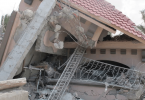TRIPOLI, Libya — NATO’s seven-month air campaign in Libya, hailed by the alliance and many Libyans for blunting a lethal crackdown by Col. Muammar el-Qaddafi and helping to push him from power, came with an unrecognized toll: scores of civilian casualties the alliance has long refused to acknowledge or investigate.
By NATO’s telling during the war, and in statements since sorties ended on Oct. 31, the alliance-led operation was nearly flawless — a model air war that used high technology, meticulous planning and restraint to protect civilians from Colonel Qaddafi’s troops, which was the alliance’s mandate.
“We have carried out this operation very carefully, without confirmed civilian casualties,” the secretary general of NATO, Anders Fogh Rasmussen, said in November.
But an on-the-ground examination by The New York Times of airstrike sites across Libya — including interviews with survivors, doctors and witnesses, and the collection of munitions remnants, medical reports, death certificates and photographs — found credible accounts of dozens of civilians killed by NATO in many distinct attacks. The victims, including at least 29 women or children, often had been asleep in homes when the ordnance hit.
In all, at least 40 civilians, and perhaps more than 70, were killed by NATO at these sites, available evidence suggests. While that total is not high compared with other conflicts in which Western powers have relied heavily on air power, and less than the exaggerated accounts circulated by the Qaddafi government, it is also not a complete accounting. Survivors and doctors working for the anti-Qaddafi interim authorities point to dozens more civilians wounded in these and other strikes, and they referred reporters to other sites where civilian casualties were suspected.
Two weeks after being provided a 27-page memorandum from The Times containing extensive details of nine separate attacks in which evidence indicated that allied planes had killed or wounded unintended victims, NATO modified its stance.
“From what you have gathered on the ground, it appears that innocent civilians may have been killed or injured, despite all the care and precision,” said Oana Lungescu, a spokeswoman for NATO headquarters in Brussels. “We deeply regret any loss of life.”
She added that NATO was in regular contact with the new Libyan government and that “we stand ready to work with the Libyan authorities to do what they feel is right.”
NATO, however, deferred the responsibility of initiating any inquiry to Libya’s interim authorities, whose survival and climb to power were made possible largely by the airstrike campaign. So far, Libyan leaders have expressed no interest in examining NATO’s mistakes.
The failure to thoroughly assess the civilian toll reduces the chances that allied forces, which are relying ever more heavily on air power rather than risking ground troops in overseas conflicts, will examine their Libyan experience to minimize collateral deaths elsewhere. Allied commanders have been ordered to submit a lessons-learned report to NATO headquarters in February. NATO’s incuriosity about the many lethal accidents raises questions about how thorough that review will be.
NATO’s experience in Libya also reveals an attitude that initially prevailed in Afghanistan. There, NATO forces, led by the United States, tightened the rules of engagement for airstrikes and insisted on better targeting to reduce civilian deaths only after repeatedly ignoring or disputing accounts of airstrikes that left many civilians dead.
In Libya, NATO’s inattention to its unintended victims has also left many wounded civilians with little aid in the aftermath of the country’s still-chaotic change in leadership.
These victims include a boy blasted by debris in his face and right eye, a woman whose left leg was amputated, another whose foot and leg wounds left her disabled, a North Korean doctor whose left foot was crushed and his wife, who suffered a fractured skull.
The Times’s investigation included visits to more than 25 sites, including in Tripoli, Surman, Mizdah, Zlitan, Ga’a, Majer, Ajdabiya, Misurata, Surt, Brega and Sabratha and near Benghazi. More than 150 targets — bunkers, buildings or vehicles — were hit at these places.
NATO warplanes flew thousands of sorties that dropped 7,700 bombs or missiles; because The Times did not examine sites in several cities and towns where the air campaign was active, the casualty estimate could be low.
There are indications that the alliance took many steps to avoid harming civilians, and often did not damage civilian infrastructure useful to Colonel Qaddafi’s military. Elements of two American-led air campaigns in Iraq, in 1991 and 2003, appear to have been avoided, including attacks on electrical grids.
Such steps spared civilians certain hardships and risks that accompanied previous Western air-to-ground operations. NATO also said that allied forces did not use cluster munitions or ordnance containing depleted uranium, both of which pose health and environmental risks, in Libya at any time.
The alliance’s fixed-wing aircraft dropped only laser- or satellite-guided weapons, said Col. Gregory Julian, a NATO spokesman; no so-called dumb bombs were used.
While the overwhelming preponderance of strikes seemed to have hit their targets without killing noncombatants, many factors contributed to a run of fatal mistakes. These included a technically faulty bomb, poor or dated intelligence and the near absence of experienced military personnel on the ground who could help direct airstrikes.
The alliance’s apparent presumption that residences thought to harbor pro-Qaddafi forces were not occupied by civilians repeatedly proved mistaken, the evidence suggests, posing a reminder to advocates of air power that no war is cost- or error-free.
The investigation also found significant damage to civilian infrastructure from certain attacks for which a rationale was not evident or risks to civilians were clear. These included strikes on warehouses that current anti-Qaddafi guards said contained only food, or near businesses or homes that were destroyed, including an attack on a munitions bunker beside a neighborhood that caused a large secondary explosion, scattering warheads and toxic rocket fuel.
NATO has also not yet provided data to Libyans on the locations or types of unexploded ordnance from its strikes. At least two large weapons were present at sites visited by The Times. “This information is urgently needed,” said Dr. Ali Yahwya, chief surgeon at the Zlitan hospital.
Moreover, the scouring of one strike site found remnants of NATO munitions in a ruined building that an alliance spokesman explicitly said NATO did not attack.
That mistake — a pair of strikes — killed 12 anti-Qaddafi fighters and nearly killed a civilian ambulance crew aiding wounded men. It underscored NATO’s sometimes tenuous grasp of battle lines and raised questions about the forthrightness and accuracy of the alliance’s public-relations campaign.
The second strike pointed to a tactic that survivors at several sites recounted: warplanes restriking targets minutes after a first attack, a practice that imperiled, and sometimes killed, civilians rushing to the wounded.
Pressed about the dangers posed to noncombatants by such attacks, NATO said it would reconsider the tactic’s rationale in its internal campaign review. “That’s a valid point to take into consideration in future operations,” Colonel Julian said.
That statement is a shift in the alliance’s stance. NATO’s response to allegations of mistaken attacks had long been carefully worded denials and insistence that its operations were devised and supervised with exceptional care. Faced with credible allegations that it killed civilians, the alliance said it had neither the capacity for nor intention of investigating and often repeated that disputed strikes were sound.
The alliance maintained this position even after two independent Western organizations — Human Rights Watch and the Campaign for Innocent Victims in Conflict, or Civic — met privately with NATO officials and shared field research about mistakes, including, in some cases, victims’ names and the dates and locations where they died.
Organizations researching civilian deaths in Libya said that the alliance’s resistance to making itself accountable and acknowledging mistakes amounted to poor public policy. “It’s crystal clear that civilians died in NATO strikes,” said Fred Abrahams, a researcher for Human Rights Watch. “But this whole campaign is shrouded by an atmosphere of impunity” and by NATO’s and the Libyan authorities’ mutually congratulatory statements.
Mr. Abrahams added that the matter went beyond the need to assist civilians harmed by airstrikes, though he said that was important. At issue, he said, was “who is going to lose their lives in the next campaign because these errors and mistakes went unexamined, and no one learned from them?”
Human Rights Watch and Civic also noted that the alliance’s stance on civilian casualties it caused in Libya was at odds with its practices for so-called collateral damage in Afghanistan. There, public anger and political tension over fatal mistakes led NATO to adopt policies for investigating actions that caused civilian harm, including guidelines for expressing condolences and making small payments to victims or their families.
“You would think, and I did think, that all of the lessons learned from Afghanistan would have been transferred to Libya,” said Sarah Holewinski, the executive director of Civic, which helped NATO devise its practices for Afghanistan. “But many of them didn’t.”
Choosing Targets
When foreign militaries began attacking Libya’s loyalists on March 19, the United States military, more experienced than NATO at directing large operations, coordinated the campaign. On March 31, the Americans transferred command to NATO.
Seven months later, the alliance had destroyed more than 5,900 military targets by means of roughly 9,700 strike sorties, according to its data, helping to dismantle the pro-Qaddafi military and militias. Warplanes from France, Britain, the United States, Italy, Norway, Denmark, Belgium and Canada dropped ordnance. Two non-NATO nations, Qatar and the United Arab Emirates, participated on a small scale.
France carried out about a third of all strike sorties, Britain 21 percent and the United States 19 percent, according to data from each nation.
The attacks fell under two broad categories. So-called deliberate strikes were directed against fixed targets, like buildings or air-defense systems. These targets were selected and assigned to pilots before aircraft took off.
Deliberate strikes were planned to minimize risks to civilians, NATO said. In Naples, Italy, intelligence analysts and targeting specialists vetted proposed targets and compiled lists, which were sent to an operations center near Bologna, where targets were matched to specific aircraft and weapons.
For some targets, like command bunkers, NATO said, it conducted long periods of surveillance first. Drones or other aircraft chronicled the daily routines at the sites, known as “patterns of life,” until commanders felt confident that each target was valid.
Other considerations then came into play. Targeting specialists chose, for example, the angle of attack and time of day thought to pose the least risk to civilians. They would also consider questions of ordnance. These included the size and type of bomb, and its fuze.
Some fuzes briefly delay detonation of a bomb’s high-explosive charge. This can allow ordnance to penetrate concrete and explode in an underground tunnel or bunker, or, alternately, to burrow into sand before exploding — reducing the blast wave, shrapnel and risk to people and property nearby.
(NATO could also choose inert bombs, made of concrete, that can collapse buildings or shatter tanks with kinetic energy rather than an explosion. NATO said such weapons were used fewer than 10 times in the war.)
Many early strikes were planned missions. But about two-thirds of all strikes, and most of the attacks late in the war, were another sort: dynamic strikes.
Dynamic strikes were against targets of opportunity. Crews on aerial patrols would spot or be told of a potential target, like suspected military vehicles. Then, if cleared by controllers in Awacs aircraft, they would attack.
NATO said dynamic missions, too, were guided by practices meant to limit risks. On Oct. 24, Lt. Gen. Charles Bouchard of Canada, the operation’s commander, described a philosophy beyond careful target vetting or using only guided weapons: restraint. “Only when we had a clear shot would we take it,” he said.
Colonel Julian, the spokesman, said there were hundreds of instances when pilots could have released ordnance but because of concerns for civilians they held fire. Col. Alain Pelletier, commander of seven Canadian CF-18 fighters that flew 946 strike sorties, said Canada installed a special computer software modification in its planes that allowed pilots to assess the likely blast radius around an intended target and to call off strikes if the technology warned they posed too great a risk to civilians.
Colonel Julian also said that NATO broadcast radio messages and that it dropped millions of leaflets to warn Libyans to stay away from likely military targets, a practice Libyan citizens across much of the country confirmed.
A Blow to the Rebels
Civilians were killed by NATO within days of the alliance’s intervention, the available evidence shows, beginning with one of the uglier mistakes of the air war: the pummeling of a secret rebel armored convoy that was advancing through the desert toward the Qaddafi forces’ eastern front lines.
Having survived the first wave of air-to-ground attacks, the loyalists were taking steps to avoid attracting NATO bombs. They moved in smaller formations and sometimes set aside armored vehicles in favor of pickup trucks resembling those that rebels drove. Pilots suddenly had fewer targets.
On April 7, as the rebel armor lined up on a hill about 20 miles from Brega, NATO aircraft struck. In a series of attacks, laser-guided bombs stopped the formation, destroyed the rebels’ armor and scattered the anti-Qaddafi fighters, killing several of them, survivors said.
The attack continued as civilians, including ambulance crews, tried to converge on the craters and flames to aid the wounded. Three shepherds were among them.
<iframe title=”New York Times Video – Embed Player” width=”480″ height=”321″ frameborder=”0″ scrolling=”no” allowfullscreen=”true” marginheight=”0″ marginwidth=”0″ id=”nyt_video_player” src=”https://static01.nyt.com/video/players/offsite/index.html?videoId=100000001231448″></iframe>




